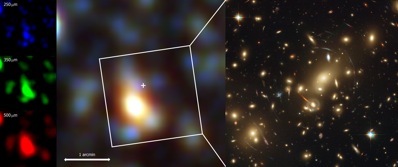



|

|

Herschel seeks out distant galaxies and quasars
DR EMILY BALDWIN
ASTRONOMY NOW
Posted: 5 July 2010


The latest data release from ESA's Herschel Space Observatory offers fresh insight into the plethora of galaxies occupying the distant Universe.
Part of the Herschel Multi-tiered Extragalactic Survey (HerMES), which uses the SPIRE instrument to observe the Universe in three submillimetre wavelengths that have, until now, rarely been used, the new data set provides vital details of temperature, distance and luminosity to previously unseen galaxies. One of SPIRE's latest targets was the imposing galaxy cluster Abell 2218, made famous by Hubble's iconic view that reveals textbook examples of gravitational lenses.
 The new SPIRE image of Abell 2218 comprises three images taken in red, green and blue wavelengths (left), combined into a colour image (middle). The centre of the cluster is indicated with the white cross. A lensed galaxy is revealed below the cross. The iconic Hubble image of the cluster is shown at right. Image: ESA/SPIRE and HerMES Consortia (left); ESA/NASA/STScI (right). The new SPIRE image of Abell 2218 comprises three images taken in red, green and blue wavelengths (left), combined into a colour image (middle). The centre of the cluster is indicated with the white cross. A lensed galaxy is revealed below the cross. The iconic Hubble image of the cluster is shown at right. Image: ESA/SPIRE and HerMES Consortia (left); ESA/NASA/STScI (right).
Over two billion light years away, the galaxy's tremendous mass warps the surrounding space, bending and magnifying light from background galaxies, an effect that was first predicted by Einstein. This natural magnifying power gives astronomers the chance to study background galaxies in more detail than otherwise possible. The new SPIRE data for Abell 2218 will add information on the rate of star formation for these early galaxies, and help paint a picture of how they evolved from the very earliest moments of the Universe's existence, right up to the present day.
“These first submillimetre views of young galaxies in the distant Universe clearly show that huge numbers of new stars are being formed, but cloaked by dust and so missed by optical observatories such as the Hubble Space Telescope,” says Ian Smail of Durham University. “It is already clear that we live in a changing Universe and, thanks to Herschel and SPIRE, few things are changing faster than our perception of it.”
The new data is also allowing astronomers to study the connection between galaxies and the supermassive black holes that reside at their centres, feeding on gas that circulates around them, and emitting vast quantities of radiation as quasars. Evanthia Hatziminaoglou of the European Southern Observatory has already found that the submillimetre emission from these so-called 'active galactic nuclei' (AGN) emanates almost exclusively from star formation, but at these wavelengths, their properties are indistinguishable from those of non-active galaxies. This finding provides evidence that supermassive black holes grow in size along with the galaxies in which they reside. “It is surprising to see that these two highly energetic astrophysical phenomena co-exist in such harmony,” she says.
The HerMES catalogue of galaxies will be released to the astronomical community so that astronomers using telescopes around the world can probe these galaxies in more detail. “Images like this show that SPIRE has opened up the possibility of observing at sub-mm wavelengths in a way which was just not possible before; this kind of clarity is unprecedented at these wavelengths,” says Michael Zemcov of the California Institute of Technology. “Now that these data are available to the entire astronomical community, we will really be able to test our understanding of objects like galaxy clusters and, more profoundly, the formation of structure in the Universe”.
|

|

|

|
|



